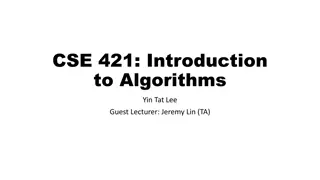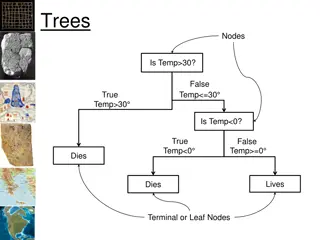2-3 Trees and Red-Black Trees
A detailed exploration of 2-3 trees and red-black trees, including definitions, properties, node structures, and traversal methods. Learn about the characteristics of 2-3 trees such as internal nodes with two or three children, maintaining leaves at the same level, and height constraints based on node count. Dive into the C++ implementation with a class for 2-3 tree nodes and understand the traversal process through inorder traversal, visiting nodes in sorted order. Enhance your understanding of these fundamental data structures in computer science.
Download Presentation

Please find below an Image/Link to download the presentation.
The content on the website is provided AS IS for your information and personal use only. It may not be sold, licensed, or shared on other websites without obtaining consent from the author.If you encounter any issues during the download, it is possible that the publisher has removed the file from their server.
You are allowed to download the files provided on this website for personal or commercial use, subject to the condition that they are used lawfully. All files are the property of their respective owners.
The content on the website is provided AS IS for your information and personal use only. It may not be sold, licensed, or shared on other websites without obtaining consent from the author.
E N D
Presentation Transcript
CS 5600 Computer Systems Lecture 5: Synchronization, Deadlock, and Lock-free Data Structures
Motivating Parallelism Synchronization Basics Types of Locks and Deadlock Lock-Free Data Structures 2
Transistors Clock Speed Power Draw Perf/Clock 3
Implications of CPU Evolution Increasing transistor count/clock speed Greater number of tasks can be executed concurrently However, clock speed increases have essentially stopped in the past few years Instead, more transistors = more CPU cores More cores = increased opportunity for parallelism 4
Concurrency vs. Parallelism Concurrent execution on a single-core system: Core 1 P1 P2 P3 P4 P1 P2 P3 P4 P1 Time Parallel execution on a dual-core system: Core 1 P1 P3 P1 P3 P1 P3 P1 P3 P1 Core 2 P2 P4 P2 P4 P2 P4 P2 P4 P2 5 Time
Two Types of Parallelism Data parallelism Same task executes on many cores Different data given to each task Example: MapReduce Task parallelism Different tasks execute on each core Example: any high-end videogame 1 thread handles game AI 1 thread handles physics 1 thread handles sound effects 1+ threads handle rendering 6
Amdahls Law Upper bound on performance gains from parallelism If I take a single-threaded task and parallelize it over N CPUs, how much more quickly will my task complete? Definition: S is the fraction of processing time that is serial (sequential) N is the number of CPU cores 1 Speedup ?+(1 ?) ? 7
Example of Amdahls Law Suppose we have an application that is 75% parallel and 25% serial 1 core: 1/(.25+(1-.25)/1) = 1 (no speedup, obviously) 2 core: 1/(.25+(1-.25)/2) = 1.6 4 core: 1/(.25+(1-.25)/4) = 2.29 What happens as N ? Speedup approaches 1/S The serial portion of the process has a disproportionate effect on performance improvement ? ? ? 8
Amdahls Law 70 0% Serial 60 10% Serial 50 25% Serial 50% Serial 40 Speedup 100% Serial 30 20 10 0 1 5 9 13 17 21 25 29 33 37 41 45 49 53 57 61 Number of Cores 9
Limits of Parallelism Amdahl s Law is a simplification of reality Assumes code can be cleanly divided into serial and parallel portions In other words, trivial parallelism Real-world code is typically more complex Multiple threads depend on the same data In these cases, parallelism may introduce errors Real-world speedups are typically < what is predicted by Amdahl s Law 10
Motivating Parallelism Synchronization Basics Types of Locks and Deadlock Lock-Free Data Structures 11
The Bank of Lost Funds Consider a simple banking application Multi-threaded, centralized architecture All deposits and withdrawals sent to the central server class account { private money_t balance; public deposit(money_t sum) { balance = balance + sum; } } What happens if two people try to deposit money into the same account at the same time? 12
balance = balance + sum; mov eax, balance mov ebx, sum add eax, ebx mov balance, eax balance $0 $100 $50 eax = $0 eax = $100 eax = $0 eax = $50 Thread 1 Thread 2 deposit($50) mov eax, balance mov ebx, sum deposit($100) Context Switch mov eax, balance mov ebx, sum add eax, ebx mov balance, eax add eax, ebx mov balance, eax Context Switch 13
Race Conditions The previous example shows a race condition Two threads race to execute code and update shared (dependent) data Errors emerge based on the ordering of operations, and the scheduling of threads Thus, errors are nondeterministic 14
Example: Linked List elem = pop(&list): tmp = list list = list->next tmp->next = NULL return tmp push(&list, elem): elem->next = list list = elem What happens if one thread calls pop(), and another calls push() at the same time? Thread 1 Thread 2 1. tmp = list 2. elem->next = list 3. list = list->next 4. list = elem 5. tmp->next = NULL tmp list list 1 2 3 list elem 4 15
Critical Sections These examples highlight the critical section problem Classical definition of a critical section: A piece of code that accesses a shared resource that must not be concurrently accessed by more than one thread of execution. Unfortunately, this definition is misleading Implies that the piece of code is the problem In fact, the shared resource is the root of the problem 16
Atomicity Race conditions lead to errors when sections of code are interleaved These errors can be prevented by ensuring code executes atomically (a) (b) Read Read Add Store Read Add Store Read Add Read Add Store Read Add Store Add Store Store Interleaved Execution Non-Interleaved (Atomic) Execution 17
Mutexes for Atomicity Mutual exclusion lock (mutex) is a construct that can enforce atomicity in code Thread 1 Thread 2 m = mutex_create(); mutex_lock(m); // do some stuff mutex_unlock(m); mutex_lock(m) (returns) critical section blocked unlock(m) (returns) (returns) critical section 18
Fixing the Bank Example Thread 1 Thread 2 LOCK class account { mutex m; money_t balance Read Add LOCK Store public deposit(money_t sum) { m.lock(); balance = balance + sum; m.unlock(); } } UNLOCK Read Add Store UNLOCK 19
Implementing Mutual Exclusion Typically, developers don t write their own locking-primitives You use an API from the OS or a library Why don t people write their own locks? Much more complicated than they at-first appear Very, very difficult to get correct May require access to privileged instructions May require specific assembly instructions Instruction architecture dependent 20
Mutex on a Single-CPU System void sema_down(struct semaphore * sema) { enum intr_level old_level; old_level = intr_disable(); while (sema->value == 0) { /* wait */ } sema->value--; intr_level(old_level); } void lock_acquire(struct lock * lock) { sema_down(&lock->semaphore); lock->holder = thread_current(); } On a single-CPU system, the only preemption mechanism is interrupts If are interrupts are disabled, the currently executing code is guaranteed to be atomic This system is concurrent, but not parallel 21
The Problem With Multiple CPUs In a multi-CPU (SMP) system, two or more threads may execute in parallel Data can be read or written by parallel threads, even if interrupts are disabled sema->value = 1 sema->value = ? CPU 1 - Thread 1 CPU 2 - Thread 2 sema_down() { sema_down() { while (sema->value == 0) { } while (sema->value == 0) { } sema->value--; sema->value--; } } 22 22
Instruction-level Atomicity Modern CPUs have atomic instruction(s) Enable you to build high-level synchronized objects On x86: The lock prefix makes an instruction atomic lock inc eax ; atomic increment lock dec eax ; atomic decrement Only legal with some instructions The xchg instruction is guaranteed to be atomic xchg eax, [addr] ; swap eax and the value in memory 23
Behavior of xchg Non-Atomic xchg Atomic xchg CPU 1 memory CPU 2 memory CPU 1 CPU 2 eax: 2 0 0 1 1 1 eax: 1 0 0 1 2 2 eax: 2 eax: 1 2 0 1 0 0 2 1 1 0 0 xchg xchg xchg xchg Illegal execution Legal execution Atomicity ensures that each xchg occurs before or after xchg s from other CPUs 24
Building a Spin Lock with xchg spin_lock: mov eax, 1 xchg eax, [lock_addr] test eax, eax jnz spinlock CPU 1 locks. CPUs 0 and 2 both try to lock, but cannot. CPU 1 unlocks. spin_unlock: mov [lock_addr], 0 CPU 0 locks, simply because it requested it slightly before CPU 2. 25
Building a Multi-CPU Mutex typedef struct mutex_struct { int spinlock = 0; // spinlock variable int locked = 0; // is the mutex locked? guarded by spinlock queue waitlist; // waiting threads, guarded by spinlock } mutex; void mutex_lock(mutex * m) { spin_lock(&m->spinlock); if (!m->locked){ m->locked = 1; spin_unlock(&m->spinlock); } else { m->waitlist.add(current_process); spin_unlock(&m->spinlock); yield(); // wake up here when the mutex is acquired } } } void mutex_unlock(mutex * m) { spin_lock(&m->spinlock); if (m->waitlist.empty()) { m->locked = 0; spin_unlock(&m->spinlock); } else { next_thread = m->waitlist.pop_from_head(); spin_unlock(&m->spinlock); wake(next_thread); } 27
Compare and Swap Sometimes, literature on locks refers to compare and swap (CAS) instructions CAS instructions combine an xchg and a test On x86, known as compare and exchange spin_lock: mov ecx, 1 mov eax, 0 lock cmpxchg ecx, [lock_addr] jnz spinlock cmpxchg compares eax and the value of lock_addr If eax == [lock_addr], swap ecx and [lock_addr] 28
The Price of Atomicity Atomic operations are very expensive on a multi-core system Caches must be flushed CPU cores may see different values for the same variable if they have out-of-date caches Cache flush can be forced using a memory fence (sometimes called a memory barrier) Memory bus must be locked No concurrent reading or writing Other CPUs may stall May block on the memory bus or atomic instructions 29
Motivating Parallelism Synchronization Basics Types of Locks and Deadlock Lock-Free Data Structures 30
Other Types of Locks Mutex is perhaps the most common type of lock But there are several other common types Semaphore Read/write lock Condition variable Used to build monitors 31
Semaphores Generalization of a mutex Invented by Edsger Dijkstra Associated with a positive integer N May be locked by up to N concurrent threads Semaphore methods wait() if N > 0, N--; else sleep signal() if waiting threads > 0, wake one up; else N++ 32
The Bounded Buffer Problem Canonical example of semaphore usage Some threads produce items, add items to a list Some threads consume items, remove items from the list Size of the list is bounded class semaphore_bounded_buffer: mutex m list buffer semaphore S_space = semaphore(N) semaphore S_items = semaphore(0) get(): S_items.wait() m.lock() result = buffer.remove_head() m.unlock() S_space.signal() return result put(item): S_space.wait() m.lock() buffer.add_tail(item) m.unlock() S_items.signal() 33
Example Bounded Buffer buffer S_items S_space Thread 1 Thread 2 Thread 3 Thread 4 [] 0 2 [a] 1 1 put(a) [a, b] 2 0 put(b) put(c) [b] 1 1 get() [b, c] 2 0 34
Read/Write Lock Sometimes known as a shared mutex Many threads may hold the read lock in parallel Only one thread may hold the write lock at a time Write lock cannot be acquired until all read locks are released New read locks cannot be acquired if a writer is waiting Ideal for cases were updates to shared data are rare Permits maximum read parallelization 35
Example Read/Write Lock list readers writers Thread 1 Thread 2 Thread 3 [a, b] 0 0 [a, b] 1 0 lock_r() [a, b] 2 0 lock_r() lock_w() [a, b] 1 0 unlock_r() [a, b] 0 0 unlock_r() [a, b] 0 1 [a, b, c] 0 1 lock_r() [a, b, c] 0 0 unlock_w() [a, b, c] 1 0 [a, b, c] 1 0 36
When is a Semaphore Not Enough? class weighted_bounded_buffer: mutex m list buffer int totalweight put(item): m.lock() buffer.add_tail(item) totalweight += item.weight m.unlock() get(weight): while (1): m.lock() if totalweight >= weight: result = buffer.remove_head() totalweight -= result.weight m.unlock() return result else: m.unlock() yield() No guarantee the condition will be satisfied when this thread wakes up Lots of useless looping :( In this case, semaphores are not sufficient weight is an unknown parameter After each put(), totalweight must be checked 37
Condition Variables Construct for managing control flow amongst competing threads Each condition variable is associated with a mutex Threads that cannot run yet wait() for some condition to become satisfied When the condition is satisfied, some other thread can signal() to the waiting thread(s) Condition variables are not locks They are control-flow managers Some APIs combine the mutex and the condition variable, which makes things slightly easier 38
Condition Variable Example class weighted_bounded_buffer: mutex m condition c list buffer int totalweight = 0 int neededweight = 0 put(item): m.lock() buffer.add_tail(item) totalweight += item.weight if totalweight >= neededweight and neededweight > 0: c.signal(m) else: m.unlock() get(weight): m.lock() if totalweight < weight: neededweight += weight c.wait(m) signal() hands the locked mutex to a waiting thread neededweight -= weight result = buffer.remove_head() totalweight -= result.weight m.unlock() return result wait() unlocks the mutex and blocks the thread When wait() returns, the mutex is locked In essence, we have built a construct of the form: wait_until(totalweight >= weight) 39
Monitors Many textbooks refer to monitors when they discuss synchronization A monitor is just a combination of a mutex and a condition variable There is no API that gives you a monitor You use mutexes and condition variables You have to write your own monitors In OO design, you typically make some user-defined object a monitor if it is shared between threads Monitors enforce mutual exclusion Only one thread may access an instance of a monitor at any given time synchronized keyword in Java is a simple monitor 40
Be Careful When Writing Monitors Original Code Modified Code get(weight): m.lock() if totalweight < weight: neededweight += weight c.wait(m) get(weight): m.lock() if totalweight < weight: neededweight += weight c.wait(m) neededweight -= weight result = buffer.remove_head() totalweight -= result.weight m.unlock() return result result = buffer.remove_head() totalweight -= result.weight m.unlock() return result put(item): m.lock() buffer.add_tail(item) totalweight += item.weight if totalweight >= neededweight and neededweight > 0: c.signal(m) neededweight -= item.weight else: m.unlock() Incorrect! The mutex is not locked at this point in the code put(item): m.lock() buffer.add_tail(item) totalweight += item.weight if totalweight >= neededweight and neededweight > 0: c.signal(m) else: m.unlock() 41
Pthread Synchronization API Mutex Condition Variable pthread_cond_t c; pthread_cond_init(&c, NULL); pthread_cond_wait(&c &m); pthread_cond_signal(&c); pthread_cond_broadcast(&c); pthread_cond_destroy(&c); pthread_mutex_t m; pthread_mutex_init(&m, NULL); pthread_mutex_lock(&m); pthread_mutex_trylock(&m); pthread_mutex_unlock(&m); pthread_mutex_destroy(&m); Read/Write Lock POSIX Semaphore sem_t s; sem_init(&s, NULL, <value>); sem_wait(&s); sem_post(&s); sem_getvalue(&s, &value); sem_destroy(&s); pthread_rwlock_t rwl; pthread_rwlock_init(&rwl, NULL); pthread_rwlock_rdlock(&rwl); pthread_rwlock_wrlock(&rwl); pthread_rwlock_tryrdlock(&rwl); pthread_rwlock_trywrlock(&rwl); pthread_rwlock_unlock(&rwl); pthread_rwlock_destroy(&rwl); 42
Thread 2 Thread 1 Layers of Locks mutex A mutex B lock A lock B // do something unlock B unlock A lock B lock A // do something unlock A unlock B Thread 1 Thread 2 Thread 1 Thread 2 Thread 1 Thread 2 lock(A) lock(A) lock(A) lock(B) lock(B) lock(B) lock(B) lock(A) lock(B) unlock(B) unlock(B) unlock(b) unlock(A) lock(A) lock(B) lock(A) unlock(A) unlock(A) unlock(B) Deadlock :( unlock(B) 43
When Can Deadlocks Occur? Four classic conditions for deadlock 1. Mutual exclusion: resources can be exclusively held by one process 2. Hold and wait: A process holding a resource can block, waiting for another resource 3. No preemption: one process cannot force another to give up a resource 4. Circular wait: given conditions 1-3, if there is a circular wait then there is potential for deadlock One more issue: 5. Buggy programming: programmer forgets to release one or more resources 44
Circular Waiting Simple example of circular waiting Thread 1 holds lock a, waits on lock b Thread 2 holds lock b, waits on lock a Thread 2 Thread 1 Thread 2 lock(A) lock(B) lock(B) lock(A) Lock A Lock B Thread 1 45
Avoiding Deadlock If circular waiting can be prevented, no deadlocks can occur Technique to prevent circles: lock ranking 1. Locate all locks in the program 2. Number the locks in the order (rank) they should be acquired 3. Add assertions that trigger if a lock is acquired out- of-order No automated way of doing this analysis Requires careful programming by the developer(s) 46
Lock Ranking Example Thread 2 Thread 1 #1: mutex A #2: mutex B lock A assert(islocked(A)) lock B // do something unlock B unlock A assert(islocked(A)) lock B lock A // do something unlock A unlock B Rank the locks Add assertions to enforce rank ordering In this case, Thread 2 assertion will fail at runtime 47
When Ranking Doesnt Work Example: Thread Safe List In some cases, it may be impossible to rank order locks, or prevent circular waiting In these cases, eliminate the hold and wait condition using trylock() class SafeList { method append(SafeList more_items){ lock(self) lock(more_items) Problem: Safelist A, B Thread 1: A.append(B) Thread 2: B.append(A) Solution: Replace lock() with trylock() method append(SafeList more_items){ while (true) { lock(self) if (trylock(more_items) == locked_OK) break unlock(self) } // now both lists are safely locked 48
Motivating Parallelism Synchronization Basics Types of Locks and Deadlock Lock-Free Data Structures 49
Beyond Locks Mutual exclusion (locking) solves many issues in concurrent/parallel applications Simple, widely available in APIs (Relatively) straightforward to reason about However, locks have drawbacks Priority inversion and deadlock only exist because of locks Locks reduce parallelism, thus hinder performance 50
Lock-Free Data Structures Is it possible to build data structures that are thread-safe without locks? YES Lock-free data structures Include no locks, but are thread safe However, may introduce starvation Due to retry loops (example in a few slides) 51























